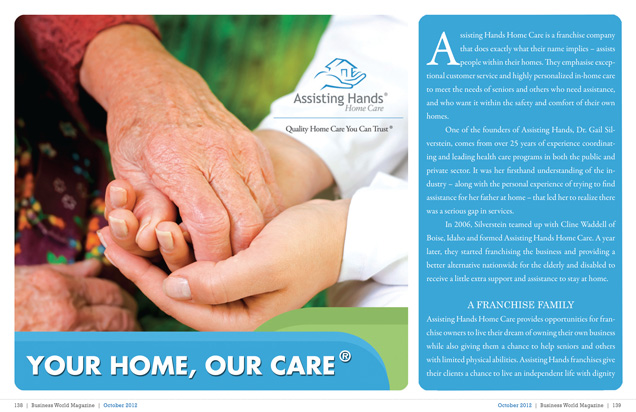

The Joint Commission sets the standards by which leading health care organizations’ quality and safety is measured. An independent, not-for-profit organization, The Joint Commission accredits and certifies more than 20,000 health care organizations and programs in the United States. The Joint Commission’s 60-plus years of experience demonstrate that accreditation is among the most comprehensive and powerful tools available to stimulate quality improvement and patient safety. Accreditation has played a major role in issues ranging from establishing smoke-free health care facilities to emphasizing a patients’ rights to care that respects their values, beliefs and preferences.
 A Mission to Improve Health Care
The Joint Commission’s mission is to continuously improve health care for the public, in collaboration with other stakeholders, by evaluating health care organizations and inspiring them to excel in providing safe and effective care of the highest quality and value. This mission supports a vision that all people always experience the safest, highest quality, best-value health care across all health care settings.
Today’s Joint Commission evolved from the “end result system of hospital standardization†proposed by Ernest Codman, M.D. Dr. Codman’s system of tracking the effectiveness of hospital treatments and using that information to improve patient care led his colleague Franklin Martin, M.D. to establish the American College of Surgeons (ACS) in 1913. The “end result†system became the ACS stated objective and was used in its Hospital Standardization Program. The Hospital Standardization Program served as the basis for the creation of The Joint Commission by the ACS, American College of Physicians (ACP), the American Hospital Association (AHA), the American Medical Association (AMA), and the Canadian Medical Association (CMA) in 1951. In 1959 the CMA withdrew as a corporate member to form its own accrediting organization in Canada. The American Dental Association joined as a corporate member in 1979
Accreditation and Certification
Seeking accreditation and certification from The Joint Commission is a voluntary decision to pursue achievement of the highest standards for quality and safety for the delivery of health care. For selected accreditation programs, Joint Commission accreditation can provide a health care organization with eligibility for deemed status from the Centers for Medicare & Medicaid Services. The Joint Commission’s 20,000 accredited and certified organizations are comprised of health care organizations and clinical programs across the continuum of care. Hospitals and home care services are the largest segments of organizations that seek Joint Commission accreditation. In addition, The Joint Commission accredits laboratories, ambulatory care facilities, long-term care facilities, office-based surgery centers and behavioral health care organizations. The Joint Commission also provides certification of health care staffing services and more than 2,400 programs have earned Joint Commission certification in programs devoted to improving the care of patients with chronic diseases and conditions such as stroke, joint replacement, diabetes, and heart failure.
To earn and maintain The Joint Commission’s Gold Seal of Approval, an organization must undergo an on-site survey by a Joint Commission survey team every three years, and laboratories must be surveyed every two years. During the on-site evaluation, Joint Commission expert surveyors examine crucial issues such as the safe use of medications, infection prevention and control, patient assessment, and patient rights. This rigorous process requires hospitals and other health care organizations to demonstrate a track record of standards compliance. Accreditation and certification also includes candid interviews with patients, families, and staff about care practices.
Organizations want an accreditation and certification process that helps them to provide safe, high-quality care on a daily basis, and The Joint Commission is committed to meeting this need. This is the value of accreditation. Specifically, The Joint Commission helps accredited and certified organizations to:
- Organize and strengthen patient safety efforts and reduce risks;
- Strengthen community confidence in the quality and safety of care;
- Provide professional advice and counsel, enhancing staff education;
- Improve the quality of patient care by reducing variation in clinical processes;
- Provide a framework for program structure and management;
- Provide an objective assessment of clinical excellence;
- Create cohesive clinical teams; and
- Promote a culture of excellence across the organization.
Improving Patient Safety and Health Care Quality
One of the greatest challenges facing health care is providing reliably safe, high-quality care. The Joint Commission has a more than 60-year history of improving health care through accreditation and certification. Each time The Joint Commission raised the bar on quality and patient safety, its accredited and certified organizations and the health care professionals in those organizations have met the challenge, to the benefit of the patients they serve. As part of The Joint Commission’s accreditation and certification process, organizations have met important standards to improve patient-centered communications and bridge gaps in culture and language, as well as National Patient Safety Goals that address specific safety concerns, including infection prevention and medication safety.
Today, the future of health care is being shaped by the Joint Commission Center for Transforming Healthcare as it aims to solve health care’s most critical safety and quality problems. The Center’s work to date has focused on hand hygiene, hand-off communications, wrong site surgery, surgical site infections, preventing avoidable heart failure hospitalizations, safety culture, preventing falls with injury, sepsis, and insulin safety. The Center’s participants – some of the nation’s leading hospitals and health systems – use a systematic approach to analyze specific breakdowns in care and discover their underlying causes to develop targeted solutions that solve these complex problems. The Joint Commission shares these proven effective solutions with the more than 20,000 health care organizations it accredits and certifies. By testing, validating the results, and communicating the most effective solutions, the Center provides health care organizations with valuable knowledge, tested tools and better strategies to deliver safe, quality care.
In addition to the work of the Center, along with accreditation and certification standards and on-site survey processes, The Joint Commission demonstrates its commitment to safety through numerous efforts, including:
- Sentinel Event Alerts that identify specific sentinel events (an unexpected death or serious physical or psychological injury) or patient safety problems, describes their common underlying causes, and suggests steps to prevent the occurrence of these events. Much of the information and guidance provided in these Alerts is drawn from The Joint Commission’s Sentinel Event Database, one of the nation’s most comprehensive voluntary reporting systems for serious adverse events in health care. Alerts have addressed important issues such as health care worker fatigue, maternal deaths, medication mix-ups, and patient suicides.
- The Speak Up program provides patients with free safety tips on a variety of health care topics including surgery, infection control, medicines, follow-up care, medical tests, patient rights, understanding caregivers, pain management, child safety, and diabetes and dialysis care in the hospital.
The Joint Commission is also committed to providing the public with reliable information about the health care provided by our accredited and certified organizations. The Quality Check website and the annual report, Improving America’s Hospitals, are two of the online resources that are available to the public. The annual report lists hospitals and critical access hospitals that are leading the way nationally in using evidence-based care processes closely linked to positive patient outcomes, while Quality Check includes Quality Reports on Joint Commission-accredited organizations and certified programs. These reports can include accreditation and certification decision; National Patient Safety Goal compliance (when applicable); National Quality Improvement Goals performance (hospitals only); patient satisfaction data; Centers for Medicare & Medicaid Services 30 day mortality rates and 30 day readmission rates for heart attack, heart failure and pneumonia;  and special quality awards. Quality Check also provides an easy way to:
- Search for accredited and certified organizations;
- Find organizations by type of service provided within a geographic area;
- Download free hospital performance measure results; and
- Print a list of Joint Commission certified disease-specific care and health care staffing programs.
Conclusion
Joint Commission accreditation and certification is a visible commitment by an organization to improve the safety and quality of patient care, ensure a safe care environment, and continually work to reduce risks to patients and staff. The Joint Commission helps its accredited and certified organizations to improve performance, raise the safety and quality of their patient care, and demonstrate accountability. For these reasons, providers, payers and consumers recognize Joint Commission accreditation and certification as one of the most important seals of approval in health care.
For more information, please visit their website at: Â The Joint Commission







